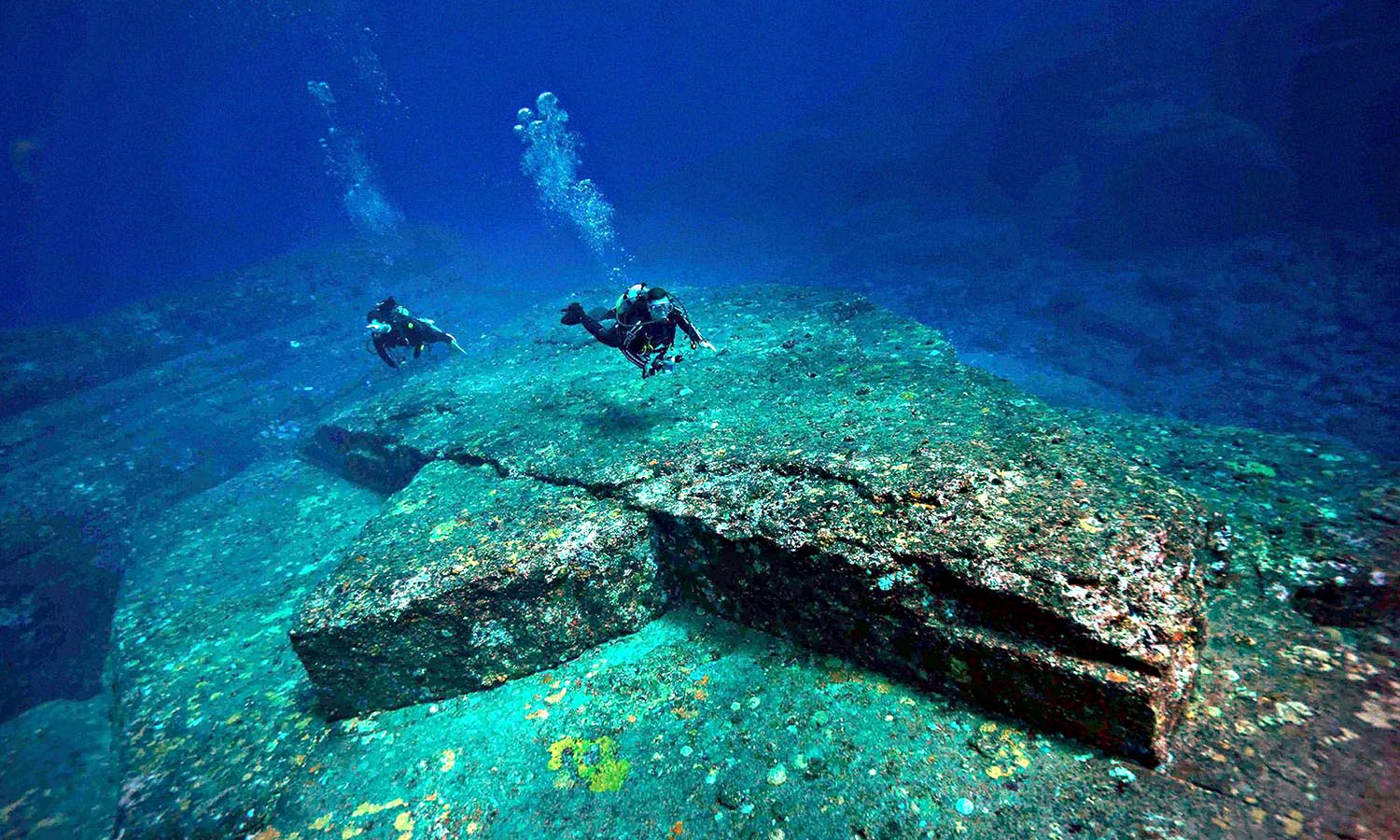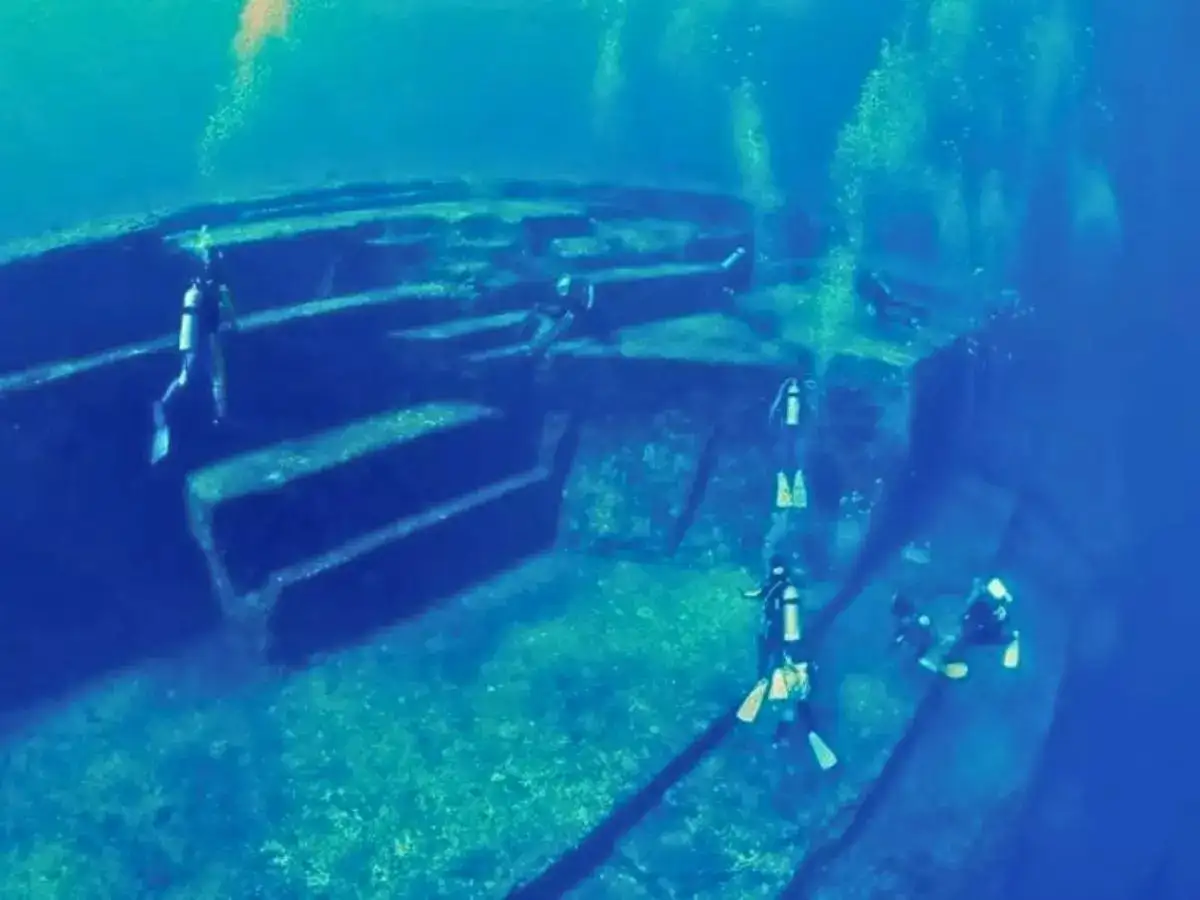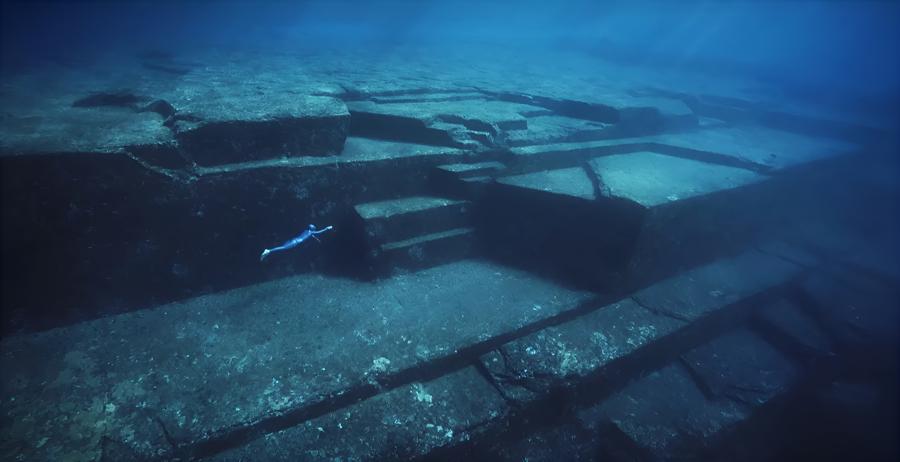One of the most talked-about underwater formations on Earth is under the turquoise waters off Japan's southernmost island. Since its discovery in 1986, the Yonaguni Monument has been the subject of heated debate among geologists, archaeologists, and fans around the world for almost four decades. Is it the remains of a highly developed ancient civilization that was swallowed by rising seas, or is it just a strange natural formation that was made by geological forces? The answer is still out of reach.

Finding things in the deep
Kihachiro Aratake, a local dive operator and head of the Yonaguni-Cho Tourism Association, was looking for new places to see hammerhead sharks in the waters off Yonaguni Island in 1986. What he found instead would fascinate the whole world. Aratake found a huge stone structure about 25 meters below the surface that he had never seen before. The formation had what looked like terraces, straight edges, and sharp angles that seemed too perfect for a natural formation.
The structure is about 150 meters long, 40 meters wide, and 27 meters tall. It is located off the southern coast of Yonaguni Island, which is the southernmost of Japan's Ryukyu Islands and about 100 kilometers east of Taiwan. The most eye-catching part of it is a series of step-like terraces that look like a ziggurat or stepped pyramid. The broad, flat surfaces are connected by what look like stairs and platforms.
The news of the find spread quickly, drawing scientists, divers, and researchers from all over the world. People started calling the site the Yonaguni Monument, but some people call it the Yonaguni Island Submarine Topography or the Yonaguni Submarine Ruins, depending on where they think it came from.
The Argument for Human Building
A marine geologist named Professor Masaaki Kimura from the University of the Ryukyus in Okinawa has become the monument's most vocal supporter of the idea that it was made by humans. Kimura has been studying the site for more than 15 years and has done more than 100 dives to record and study the formation. His research has led him to believe that the structure could not have formed on its own through natural processes.
Kimura cites various characteristics as indicators of human alteration. He says he found tool marks on the stone surfaces, quarry marks that show where blocks may have been cut, and simple characters or symbols carved into the faces. He has also talked about what he thinks are carvings of animals and human faces in the rock. Kimura says that these features point to an ancient civilization that planned and built them on purpose.

The marine geologist thinks he can see many structures in the formation, including what he calls a pyramid, castles, roads, monuments, and even a stadium. He says that roads and water channels connect these features and that they are partly protected by what could be huge retaining walls. Kimura has found ten structures off the coast of Yonaguni and five more that are related to them off the coast of Okinawa. The total area of these structures is about 300 meters by 150 meters.
At first, Kimura thought the formation was at least 10,000 years old, which would have been a time when sea levels were much lower and the structure would have been above water. If this timeline is correct, the monument was built during the last Ice Age, when Yonaguni was connected to Taiwan by a land bridge. But in a report to the 21st Pacific Science Congress in 2007, he changed his mind and said it was built between 2,000 and 3,000 years ago. He thought that tectonic activity caused the structure to sink after it was built, when sea levels were closer to where they are now.
Kimura has also suggested that the structures could be what is left of the Yamatai culture or even proof of the mythical lost continent of Mu, a Pacific civilization like Atlantis that supposedly sank into the ocean after a disaster. Some people who believe in the artificial origin theory, like Graham Hancock, who writes about alternative history, say that the fact that so many strange formations are in such a small area is very unlikely to be a coincidence.
The Scientific Doubt
Most scientists don't believe Kimura's claims. Geologists have given strong reasons for the monument's features based on how natural geological processes work. Dr. Robert Schoch, a geologist and professor of science and math at Boston University, is Kimura's main critic. He has also dived at the site several times.
Schoch's study looks at the structure and makeup of the rock formation. The Yonaguni Monument is made up of medium- to very-fine sandstones and mudstones from the Lower Miocene Yaeyama Group. These rocks were laid down about 20 million years ago. Schoch notes that these sandstones have many well-defined, parallel bedding planes that make it easy for the layers to separate. There are also many sets of parallel, vertically oriented joints that cross the rocks. These are natural cracks in the rocks.
Schoch says that these natural features are what make the monument look like it was built. The rectangular shapes, right angles, and step-like terraces are all caused by the way horizontal bedding planes and vertical joints work together. When the rocks in this formation break along these planes, they naturally make shapes that can look very geometric and even fake.
Yonaguni Island is in a very seismically active area near a tectonic fault line that is part of the Pacific Ring of Fire. Earthquakes happen a lot in this area, and they break rocks in regular, predictable ways. Over thousands of years, strong ocean currents have eroded these natural fracture lines, slowly breaking apart and removing weaker rock layers while leaving behind the stronger formations that give the monument its unique look.

Schoch also talks about similar shapes that can be found on other parts of Yonaguni Island. There are the same step-like sandstone formations along both the southeast and northeast coasts, above the waterline. The Sanninudai geosite is the best example. Natural weathering and erosion have made structures that look almost exactly like those underwater. These formations on land show that the same geological processes that are shaping the modern coast could have easily made the underwater monument.
Schoch says that Kimura's claims about tool marks and carvings are wrong. He says that these are just natural scratches and marks made by marine organisms, underwater currents, and sediment scouring the rock surface. He says that what Kimura thinks are walls are really natural horizontal platforms that fell into vertical positions when the rock underneath them eroded away. The supposed roads are just natural channels in the rock, and the supposed drainage systems are just places where water flows through existing fractures.
Wolf Wichmann, a German geologist who studied the formations on expeditions in 1999 and 2001, came to the same conclusions. Takayuki Ogata and other researchers did a thorough study of the Yonaguni Monument in 2019. They used digital elevation models and detailed geological field investigations to do this. Their research showed that the monument may look man-made, but it is actually a natural feature that formed when weathering and erosion acted on bedding planes and linear joints in sandstone.
The Archaeological Evidence That Isn't There
A significant obstacle for advocates of human construction is the almost complete lack of archaeological evidence. No tools, pottery, building materials, carved blocks that have been moved into place, or other artifacts that would definitely show that people have been there have been found at the site, even after decades of exploration and study. This lack is especially important because pottery and stone tools from ancient cultures are usually well-preserved and plentiful at real archaeological sites.
Kimura has pointed to charcoal found in buildings along the nearby coast that has been carbon-dated to about 1,600 years ago as proof that people lived in the area a long time ago. But this finding only shows that people lived on Yonaguni at that time; it doesn't link directly to the underwater monument or show that people built the formation. Pottery and stone tools have also been found in the waters around the monument. However, these items could have easily been lost at sea by people on boats or washed into the ocean from settlements on the coast.
The size of the monument also makes it hard to believe that people built it. Building something so big would have needed a lot of people with a lot of resources, organization, and technology. If Kimura's original idea that the monument is 10,000 years old is correct, it would have been built before pottery, advanced farming, and large settled communities were common in the area. Archaeological evidence from Taiwan and adjacent regions during the Pleistocene indicates the presence of small, highly mobile hunter-gatherer populations utilizing relatively rudimentary stone tool technology.
Where are the villages, cemeteries, and farms that would have been able to support a population that could build such a monument? If the monument is an ancient city or religious center, we should find a lot of evidence that people lived in the area around it, especially in higher areas that were safe from floods and earthquakes. But there is no clear evidence of this.
Official Position and Acknowledgment
The stance of the Japanese government is probably the most telling. The Yonaguni Monument is not seen as an important cultural artifact or archaeological site by either the Japanese Agency for Cultural Affairs or the Okinawa Prefecture government. Both agencies have not done any official research or preservation work on the formation, even though it is famous and brings in tourists to the area.
This lack of official recognition shows that most archaeologists and geologists agree that the monument is mostly a natural formation. If there were credible proof that humans built the site, these groups would be very interested in protecting and studying it because it could be a major discovery.
A Middle Ground?
Over the years, Schoch and Kimura have both changed their minds about some things. Schoch says that the Yonaguni Monument is mostly natural, but that people who lived on the island a long time ago may have used, improved, and changed the natural features to suit their needs. There are signs of very old human habitation on Yonaguni, such as tombs and other structures carved from bedrock that look like the island's natural step-like features.
Schoch thinks that the monument is more than 95% natural, but that some parts were changed or improved by ancient people who liked the shape and used it in their religious or cultural practices. This interpretation makes it possible for people to interact with the site without having to build the whole monument.
Kimura has also changed the way he talks about the monument in the last few years. He now calls it terraformed, which means that natural geological features have been changed or manipulated by people. This shows that he has changed his mind about the structure being completely man-made.
The Legend of Mu
The link between the Yonaguni Monument and the lost continent of Mu makes the debate even more interesting. James Churchward made the mythical Pacific continent of Mu famous in his 1926 book The Lost Continent of Mu. Some people confuse Mu with Lemuria. Churchward theorized, based on his analysis of ancient tablets, that Mu was inhabited by an advanced civilization known as the Naacal, which thrived between 50,000 and 12,000 years ago before being obliterated by a cataclysmic event and submerging beneath the Pacific Ocean.
Contemporary geology unequivocally disproves the existence of a submerged continent in the Pacific. Since the 1970s, the theory of plate tectonics has been widely accepted. It shows that continents are made up of lighter crustal rocks that float on denser oceanic rocks. In Mu mythology, a continent can just sink into the ocean. The structure of the ocean floor and the geological history of the Pacific do not support the idea that a large landmass existed and then disappeared in the time frame suggested by Mu supporters.
Still, the idea of linking the Yonaguni Monument to a lost civilization continues to fascinate people. For people who believe in Mu, the monument is proof that this mythical culture existed and that advanced civilizations existed before history and were lost in cataclysmic events. For skeptics, the Mu connection shows how fake archaeological theories can get mixed up with real geological mysteries.
Current Status and How Easy It Is to Get
The Yonaguni Monument is now a popular spot for divers from all over the world. They come for both its physical beauty and its controversial history. The site is open all year, but the months of January to March are especially busy because hammerhead sharks migrate to the area. The monument's top terrace is only 25 meters deep, which makes it easy for divers of all skill levels to get to. However, the area has strong currents, so divers should be careful and have experience.
If you don't want to get wet, you can take a glass-bottom boat tour every day. This gives you a unique view of this strange formation. The monument's fame has helped the local tourism industry, but the fact that no one knows where it came from is still the main reason people come to see it.
The Ongoing Mystery
The Yonaguni Monument is still hard to classify, almost forty years after it was found. The argument between natural formation and human construction is still going on, but scientists mostly agree that the structures are natural with maybe some small changes made by humans. The structure's natural origin is supported by the concentration of geometric features, the fact that it looks like formations above water on the island, the lack of archaeological evidence, and the geological explanation for its shape.
But the monument's visual impact is still strong. When you stand in front of the huge terraces and what looks like perfectly straight angles underwater, it's easy to see why so many people have trouble believing that they were made by nature alone. People's brains are wired to see patterns and give meaning to geometric shapes. This is a psychological phenomenon known as pareidolia, which may help explain why the monument has remained popular as a possible artifact.
Researchers and fans keep going back to Yonaguni not just because of the monument itself, but also because of what it stands for: the desire of people to learn more about our past, the idea that advanced civilizations may have existed before recorded history, and the humbling reminder that nature can create wonders that are just as impressive as human architecture. The Yonaguni Monument is a sign of the deep mysteries that are still hidden beneath the waves, whether they were carved by ancient hands or shaped by geological forces over millions of years.
The formation challenges us to stay open to new discoveries while still being scientific, to balance awe with critical thinking, and to realize that sometimes the most amazing things happen when natural forces work together over long periods of time. Until we find solid archaeological proof, the Yonaguni Monument will stay in a strange place between a geological wonder and an archaeological mystery, inviting each new group of explorers to come up with their own theories about where it came from.
